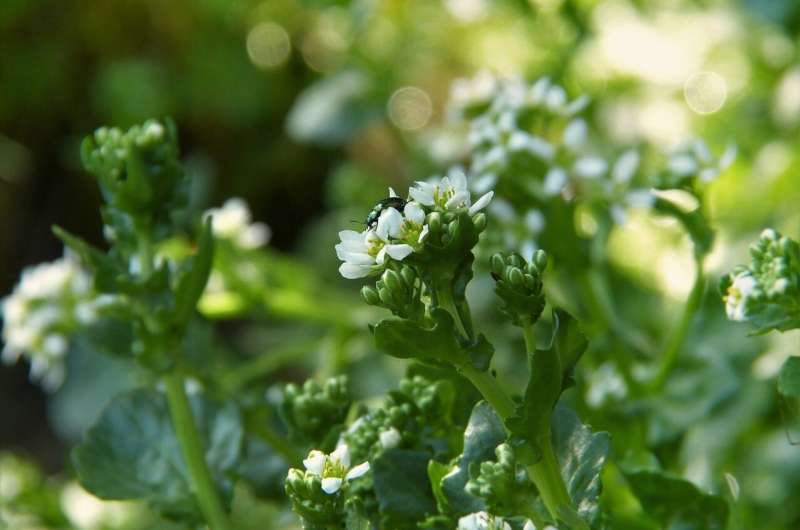Long-term restoration of a biodiversity hotspot hinges on getting seeds to the right place at the right time

In the race to restore some of North America’s most biodiverse and threatened ecosystems, a straightforward first step is likely among the most important.
New research shows that degraded savanna ecosystems can reap lasting benefits from a single seeding of native understory plants. Published this week in the journal PNAS, the study underscores the long-term value of even a brief burst of targeted land management in efforts to restore fallow agricultural fields and other landscapes scarred by decades or centuries of human activity.
The eight-year experiment led by a team of scientists at the University of Wisconsin–Madison and Michigan State University centered on three large tracts of federal land within the historical range of the longleaf pine savanna ecosystem. Longleaf pine savanna dominated portions of the southeastern United States prior to the arrival of Europeans.
This biodiversity hotspot once spanned some 90 million acres but has largely vanished. Less than 5 percent of the continent’s longleaf pine savanna remains, and much of what does persist is a shadow of the unspoiled ecosystem of the past.
“In a high-quality longleaf stand, you can find over 30 species in a square meter. It’s incredible,” says John Orrock, a professor of ecology at UW–Madison. Orrock and UW–Madison professor Ellen Damschen, an ecologist and conservation biologist, led the study with Lars Brudvig at Michigan State.
The longleaf stands where the researchers set up their experiment started out with decidedly fewer plant species than an unspoiled tract would contain.
But, after assessing more than 230 sites, the team selected 48 that met specific parameters. These criteria allowed them to gauge whether factors like the depth of fallen pine needles or the spacing between trees would measurably affect whether native understory plants could establish or persist after seeding.
Once the researchers identified their desired mix of sites, they applied herbicide to portions of some before planting them all with seeds from about two dozen species of native non-woody plants that they collected locally, including tall ironweed and sweet goldenrod. Over the course of eight years, the team returned periodically to document how successful each species was in becoming established and, crucially, how well they persisted year after year.
They found that factors like needle depth, tree spacing and seasonal temperature and precipitation did have some influence on the initial success of seeding, including germination and establishment of healthy seedlings.
Specifically, cooler and wetter conditions promoted better establishment, as did shallower needle depth and greater spacing between trees. These latter conditions reflect the ecosystem’s natural state of periodic low-intensity wildfires that burn up leaf litter and saplings. The team found that preemptive herbicide applications did not measurably affect establishment.
Once a diverse understory of savanna plants became established, its long-term persistence was relatively unaffected by environmental factors—with one exception. Higher temperatures during the height of the growing season were associated with poorer long-term survival among some species, indicating one threat posed by a warming climate.
In addition to highlighting risks of a warming climate, the results of the long-term study demonstrate that a single addition of native seeds can have clear benefits that last for years and years. The researchers are optimistic their results can help land managers direct limited resources toward restoration strategies with the greatest chance of success, especially because their study helps identify the best place and time to add seeds.
“We can custom tailor the information from these experiments to conservation or restoration practitioners,” says Orrock. “Depending on what your site is like, we can actually give you better information to increase the likelihood that you’re going to succeed in your endeavor of restoring these plant species.”
While the results are most applicable in the context of the longleaf pine savanna ecosystem, they could prove useful for management of similar ecosystems, such as the oak savanna that once dominated large swaths of Wisconsin and the Midwest.
“I see a lot of parallels in the work that we do both here in Wisconsin in tallgrass prairie and oak savanna and longleaf pine savanna in the southeast,” says Damschen. “In fact, many of the species are identical, and the major plant families are extremely similar.”
Looking forward, Orrock and Damschen say they would like to better understand the traits of species and even individual plants that might help them germinate and establish healthy seedlings. This type of knowledge could prove especially useful for land managers dealing with new and rapidly unfolding environmental conditions associated with a changing climate.
More information:
Orrock, John L., Long-term, large-scale experiment reveals the effects of seed limitation, climate, and anthropogenic disturbance on restoration of plant communities in a biodiversity hotspot, Proceedings of the National Academy of Sciences (2023). DOI: 10.1073/pnas.2201943119. doi.org/10.1073/pnas.2201943119
Citation:
Long-term restoration of a biodiversity hotspot hinges on getting seeds to the right place at the right time (2023, February 6)
retrieved 6 February 2023
from https://phys.org/news/2023-02-long-term-biodiversity-hotspot-hinges-seeds.html
This document is subject to copyright. Apart from any fair dealing for the purpose of private study or research, no
part may be reproduced without the written permission. The content is provided for information purposes only.
For all the latest Science News Click Here
For the latest news and updates, follow us on Google News.

